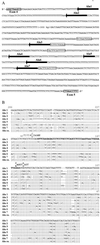Two major forms of DNA (cytosine-5) methyltransferase in human somatic tissues
- PMID: 10449766
- PMCID: PMC22282
- DOI: 10.1073/pnas.96.17.9751
Two major forms of DNA (cytosine-5) methyltransferase in human somatic tissues
Abstract
Thus far, only one major form of vertebrate DNA (cytosine-5) methyltransferase (CpG MTase, EC 2.1.1.37) has been identified, cloned, and extensively studied. This enzyme, dnmt1, has been hypothesized to be responsible for most of the maintenance as well as the de novo methylation activities occurring in the somatic cells of vertebrates. We now report the discovery of another abundant species of CpG MTase in various types of human cell lines and somatic tissues. Interestingly, the mRNA encoding this CpG MTase results from alternative splicing of the primary transcript from the Dnmt1 gene, which incorporates in-frame an additional 48 nt between exons 4 and 5. Furthermore, this 48-nt exon sequence is derived from the first, or the most upstream, copy of a set of seven different Alu repeats located in intron 4. The ratios of expression of this mRNA to the expression of the previously known, shorter Dnmt1 mRNA species, as estimated by semiquantitative reverse transcription-PCR analysis, range from two-thirds to three-sevenths. This alternative splicing scheme of the Dnmt1 transcript seems to be conserved in the higher primates. We suggest that the originally described and the recently discovered forms of CpG MTase be named dnmt1-a and dnmt1-b, respectively. The evolutionary and biological implications of this finding are discussed in relation to the cellular functions of the CpG residues and the CpG MTases.
Figures








Similar articles
-
One-codon alternative splicing of the CpG MTase Dnmt1 transcript in mouse somatic cells.FEBS Lett. 2000 Mar 3;469(1):101-4. doi: 10.1016/s0014-5793(00)01254-0. FEBS Lett. 2000. PMID: 10708765
-
Characterization of the human DNA methyltransferase splice variant Dnmt1b.J Biol Chem. 2000 Apr 14;275(15):10754-60. doi: 10.1074/jbc.275.15.10754. J Biol Chem. 2000. PMID: 10753866
-
Identification and characterization of alternatively spliced variants of DNA methyltransferase 3a in mammalian cells.Gene. 2002 Sep 18;298(1):91-9. doi: 10.1016/s0378-1119(02)00976-9. Gene. 2002. PMID: 12406579
-
The Roles of Human DNA Methyltransferases and Their Isoforms in Shaping the Epigenome.Genes (Basel). 2019 Feb 23;10(2):172. doi: 10.3390/genes10020172. Genes (Basel). 2019. PMID: 30813436 Free PMC article. Review.
-
Mammalian DNA (cytosine-5) methyltransferases and their expression.Clin Immunol. 2003 Oct;109(1):6-16. doi: 10.1016/s1521-6616(03)00204-3. Clin Immunol. 2003. PMID: 14585271 Review.
Cited by
-
High-fat or ethinyl-oestradiol intake during pregnancy increases mammary cancer risk in several generations of offspring.Nat Commun. 2012;3:1053. doi: 10.1038/ncomms2058. Nat Commun. 2012. PMID: 22968699 Free PMC article.
-
Mobile DNA and the TE-Thrust hypothesis: supporting evidence from the primates.Mob DNA. 2011 May 31;2(1):8. doi: 10.1186/1759-8753-2-8. Mob DNA. 2011. PMID: 21627776 Free PMC article.
-
Altered DNA Methylation Profiles in SF3B1 Mutated CLL Patients.Int J Mol Sci. 2021 Aug 28;22(17):9337. doi: 10.3390/ijms22179337. Int J Mol Sci. 2021. PMID: 34502260 Free PMC article.
-
Vitamin B12 deficiency in the brain leads to DNA hypomethylation in the TCblR/CD320 knockout mouse.Nutr Metab (Lond). 2012 May 18;9:41. doi: 10.1186/1743-7075-9-41. Nutr Metab (Lond). 2012. PMID: 22607050 Free PMC article.
-
DNA methyltransferase isoforms expression in the temporal lobe of epilepsy patients with a history of febrile seizures.Clin Epigenetics. 2019 Aug 19;11(1):118. doi: 10.1186/s13148-019-0721-2. Clin Epigenetics. 2019. PMID: 31426844 Free PMC article.
References
-
- Jost J P, Saluz H P, editors. DNA Methylation: Molecular Biology and Biological Significance. Basel: Birkhauser; 1993.
-
- Bestor T H, Verdine G L. Curr Opin Cell Biol. 1994;6:386–389. - PubMed
-
- Bestor T H. Nature (London) 1998;393:311–312. - PubMed
-
- Jones P A, Buckley J D. Adv Cancer Res. 1990;54:1–23. - PubMed
-
- Baylin S B. Science. 1997;277:1948–1949. - PubMed
Publication types
MeSH terms
Substances
Associated data
- Actions
- Actions
- Actions
LinkOut - more resources
Full Text Sources
Molecular Biology Databases
Research Materials

